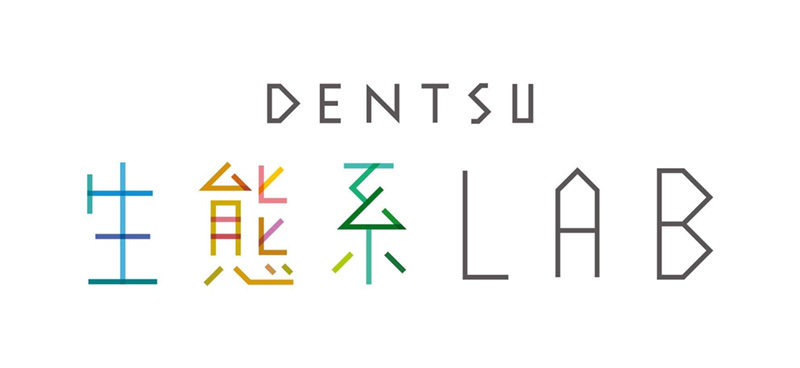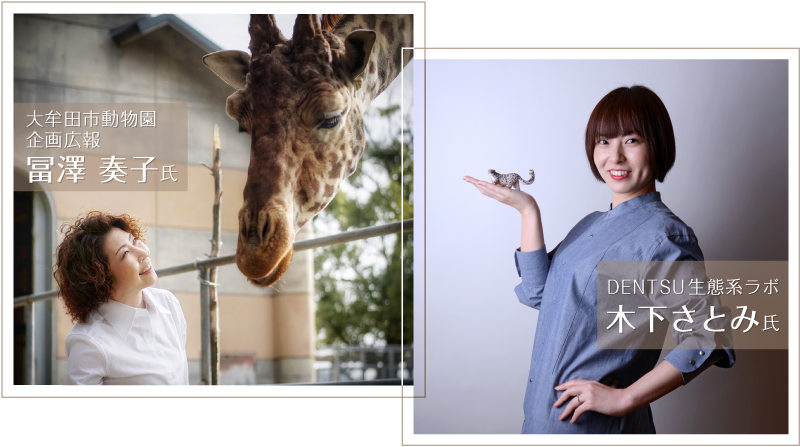How will zoos overcome the pandemic and evolve?

Kanako Tomizawa
Omuta City Zoo

Satomi Kinoshita
Dentsu Inc.
DENTSU Ecosystem LAB tackles various challenges in ecosystem conservation and explores communication strategies for solving them. During the pandemic, it has partnered with zoos nationwide to connect zoos with the public.

How will zoos change in the era of living with COVID-19? Satoko Tomizawa, Planning and Public Relations Manager at Omuta City Zoo, and Satomi Kinoshita, a LAB member, discuss this topic.
【Omuta City Zoo】
A municipal zoo located in Omuta City, southern Fukuoka Prefecture. It houses approximately 200 animals across 50 species. Guided by the concept of "a zoo that communicates animal welfare," it strives to create environments where animals can exhibit the diverse behaviors they would display in the wild, implementing various initiatives toward this goal.
https://omutacityzoo.org/
【DENTSU Ecosystem LAB】
A planning and creative unit that partners with researchers of wildlife, forests, rivers, and oceans, endangered species conservation groups, zoos, aquariums, and others to create communications centered on environmental challenges, ecosystem conservation, and the SDGs.

"Support by Watching: Everyone's Zoo" – Support the zoo just by watching videos
Kinoshita: During the state of emergency declaration in spring 2020, zoos and aquariums nationwide were forced to close. Could you share the situation at Omuta City Zoo at that time?
Tomizawa: Yes. At that time, we were forced to close for over a month and a half. This year marks our 80th anniversary, and in our entire 80-year history, this was the first time we had to close for such a long period due to an emergency. Typically, April to June and September to November are our peak field trip seasons, when we welcome many group visitors. However, nearly all of those bookings were canceled. Consequently, our admission revenue has decreased significantly.
Kinoshita: Did the animals also suffer any effects?
Tomizawa: Even during the state of emergency, the animals continued living their daily lives, full of energy as always. Precisely because of that, I kept thinking about how we could convey their well-being to our visitors.
Kinoshita: That's right. During last year's state of emergency, we closed during Golden Week, our busiest period. Even though our staff continued working, the zoo received no return for their efforts. We desperately wanted to find a way to change that situation.
That's why, precisely because we now live in an era where videos can be viewed for free on platforms like YouTube, we discussed with the DENTSU Ecosystem LAB members about creating a system where simply watching videos generates advertising revenue for the zoo, thereby supporting it. This led us to launch the project "Watch and Support: Everyone's Zoo."

【Watch and Support: Everyone's Zoo】
From May 1 to 31, 2020, we streamed free videos of animals from eight zoos nationwide across various media platforms. We delivered footage, including behind-the-scenes glimpses not usually seen. The advertising revenue generated from video views was returned to each zoo by the media companies.
Kinoshita: It was regrettable that we couldn't invite all zoos to participate, as this project was implemented urgently during the state of emergency. However, the participating zoos provided videos immediately, allowing us to start streaming in less than two weeks after planning. Initially, we asked the comprehensive pet media platform "PECO" to handle the streaming. PECO is a media platform where dog and cat lovers gather. While people who love dogs and cats generally like animals, I felt their interests surprisingly didn't often extend beyond dogs and cats. So, I thought "See and Support: Everyone's Zoo" could be a great opportunity to introduce them to the appeal of other animals.
We then asked HuffPost Japan to feature the project. Since many readers of that media outlet are socially conscious and interested in current affairs, we wanted to appeal to them as a social issue. We also aimed to reach people who hadn't previously engaged with zoos, hoping this would help zoos attract new customers.
During the campaign period, the combined Twitter and YouTube videos from all participating zoos garnered around 330,000 views. HuffPost Japan also covered the project on Twitter, making the response easy to gauge. Tweets included comments like, "So this is the kind of challenge zoos are facing now," and "If just watching helps support them, I'll give the videos a try."
Tomizawa: After the project ended, we were shown the video view statistics along with the advertising revenue report. While every zoo provided their best videos, the difference in view counts between popular and less popular ones was striking. That sparked my deep interest in analyzing why certain videos were popular. Seeing and learning from the videos of other zoos was also a major takeaway.
The "Zoo All to Yourself" Online Project Born During the Pandemic
Kinoshita: During the state of emergency, Omuta City Zoo launched a project to share lively footage of the animals, right?
Tomizawa: That's right. First, from May 1st to 5th, 2020, we conducted live streams on our official Facebook account, each focusing on one type of animal. We'd wanted to do live streams before. But doing them during opening hours meant staff would have to stand between visitors and the animals for filming. This would prevent visitors from observing the animals properly, so we hadn't been able to make it happen. We decided to do it precisely because we were closed.
Actually, we had previously filmed and edited animal footage to upload to Facebook and YouTube. However, live streaming offered real-time, two-way communication with visitors via chat, resulting in a completely different response. It was incredibly fun for us too. The view count difference between live streams and regular videos was like night and day.
On the other hand, we also identified the challenge of communicating with every single viewer through chat. Could we find a way to offer live streams to individual visitors? That's how the "Zoo Just for You" project was born.

【Zoo Private Tour】
A paid event launched on June 1st last year, allowing participants to enjoy the zoo online. It features a 40-minute customized live video tour guided by staff. Participants can share their preferred animals or topics of interest with the zoo beforehand, enabling the content to be tailored to their requests. Up to five people can join per session, and a key appeal is sharing the screen with family or friends living far away to enjoy the conversation together.
Kinoshita: I also had the chance to watch videos from participants. In a way, it's like having the keeper all to yourself—you get detailed explanations and tips on what to look for while viewing the animals. Plus, the fact that it's customized for you really makes you appreciate the animals more.
Tomizawa: Thank you. But we agonized over the pricing. We worried that charging ¥5,000 for this program, compared to our ¥380 admission fee, might seem unrealistically high. Since nearly all our in-park events have been free until now, we were very uncertain if customers would actually sign up for a paid option.
That said, considering the potential growth of online initiatives, the initial pricing would significantly influence future market rates. So we decided to boldly start at ¥5,000.
For the first month after launch, we had almost no participants. So, we asked the deputy editor-in-chief of HuffPost Japan, who had introduced us during the "See and Support: Everyone's Zoo" campaign, to write an article about "Zoo for One." After that, many customers began signing up. It was an experience that made me realize once again how important human connections are.
Kinoshita: I'm glad if I could be of even a little help.
Tomizawa: Thank you. It really helped. The success of "Zoo for One" led to Omuta City adopting this project as a return gift for their hometown tax program. As the city zoo, we constantly think about how we can give back to our citizens, so I feel like we've achieved one of those goals.
The key to future zoo business lies in "online."
Kinoshita: When considering the future of zoo operations, online video streaming seems to be the key, doesn't it?
Tomizawa: That's right. I believe every zoo has started putting more effort into video production since last year. Here at our zoo, we're gradually advancing initiatives to help people understand zoos better by collaborating with zoos and related organizations both domestically and internationally to create compelling videos together. We'd be delighted if you could check outthe Oomuta City Zoo's official YouTube, Facebook,and Instagram. We received advice from Mr. Kinoshita regarding video production, didn't we?
Kinoshita: For example, when filming animals, if a person stands and shoots, the footage tends to end up from a human perspective. I believe people crave immersion—when observing animal behavior, they want to see it from the animal's viewpoint. I suggested trying to film as much as possible from the animal's perspective and incorporating storytelling into animal introductions.
Tomizawa: I believe online video distribution will become increasingly important for our zoo going forward. For small regional zoos like ours, where it's physically difficult for people to visit, reaching more people online is a huge opportunity. Of course, we must continue to consider how to turn the interest sparked by our videos into actual visits to the zoo.
Kinoshita: The core of our daily advertising work is figuring out how to communicate in ways that resonate with people and prompt real action. To convey the animals' charm as effectively as possible, we plan to keep proposing various ideas. Beyond video streaming, we're currently launching a project to install animal-themed capsule toy machines at each zoo.

Zoo merchandise is usually designed individually for each zoo. We thought that by deliberately using the same design across zoos, we could highlight each zoo's unique character. For example, Okinawa might feature endemic species, while a monkey-specialized zoo could showcase various monkey species. Furthermore, instead of using scientific names, we design using individual names like Taro or Hanako. This sparks curiosity—what kind of animal is this?—before conveying their ecology. Since the animal appears through the gacha gacha, we hope visitors will develop an attachment to it first.
There's so much to learn from how animals live.
Kinoshita: I've always loved animals and visit zoos often. When you really observe them closely, it's like you're facing them not as humans versus animals, but as one living creature to another. By becoming a living being myself and observing animals, I realize things like how to overcome difficulties, how to live, or even that maybe I don't need to do anything at all (laughs). We at DENTSU Ecosystem LAB also want to propose projects that apply these lessons from animals to daily life and business.
Tomizawa: As Mr. Kinoshita mentioned, I believe there's much to learn from animals. Zoos hold significant value as accessible places where we can learn about animal ecology. That's precisely why we strive to ensure animals live vibrant lives, fully expressing their natural behavioral diversity. We manage their populations to appropriate levels with animal welfare in mind, while continuously updating their habitats to improve their quality of life. Our mission is to accurately assess each animal's condition, prioritize what is best for them at any given moment, and effectively convey the unique charm of every animal.
Kinoshita: I was struck by something a zoo professional once said: "People only visit the zoo three times in their lives." The first time is as a child, the second when they become parents, and the third when they become grandparents. Animals truly teach us so much, so I really hope more people will visit zoos.
Tomizawa: That's right. I believe animals also teach us a great deal about what truly matters in our human environment. That's precisely why we want to consider and share insights beyond mere "cuteness" – hints for how humans and animals can coexist, and how we can enrich the lives of animals. This also connects to thinking about the richness of our own human lives and the Earth's environment. We would be delighted if zoos could become a place that sparks such reflection.
Was this article helpful?
Newsletter registration is here
We select and publish important news every day
For inquiries about this article
Author

Kanako Tomizawa
Omuta City Zoo
Ph.D. in Environmental Studies. A lifelong animal lover, he has dedicated over 20 years to wildlife conservation. At Omuta City Zoo, he oversees planning and public relations, communicating the zoo's diverse initiatives through various formats. Part-time lecturer at Teikyo University of Science. Vice Chair of the Species Management Committee for the Southeast Asia Zoos and Aquariums Association. Board member of the International Association of Zoo Educators.

Satomi Kinoshita
Dentsu Inc.
My twin sister from Hyogo Prefecture. She's been a Yuming fan since childhood. At Dentsu Inc., she worked as a copywriter handling advertising communications for various companies. Leveraging her expertise and connections regarding endangered species, she's currently also handling animal-related projects.

